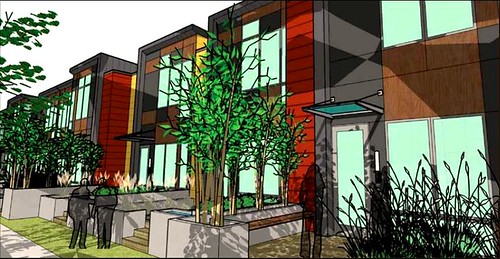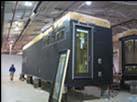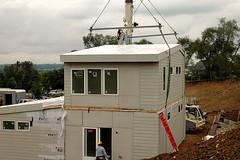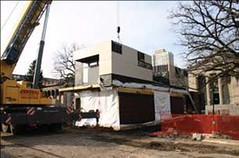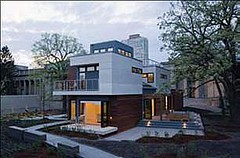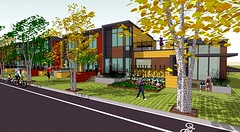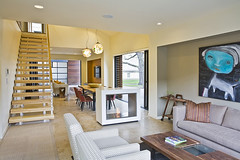Denver's Aria raises the bar for smart, sustainable neighborhoods - with prefab construction!

Posted August 25, 2009 at 1:36PM
"Denver wants to be the kind of place that brings a lot of innovative ideas," says Denver mayor John Hickenlooper. "What could be more innovative than to build a totally green, pre-fab, multiple- unit community on the site of a convent? This is going to be a great development. I think it brings to Denver just the kind of development that we want to be known for."
That pretty much sums up the redevelopment-in-progress known as Aria Denver, on a 25-acre site previously owned by the Sisters of St. Francis, a Roman Catholic order, in northwest Denver,. The stated goal of the development partnership of Perry Rose and Urban Ventures is to continue the legacy of stewardship and community fostered by the Sisters through creation of "a replicable model of environmentally, socially, and economically responsible community development-one that creates a diverse, tight knit community with a sense of place, and that increases residents' health and the health of our environment." (Perry Rose, which also developed the well-known smart/green project, Highlands' Garden Village, also in Denver, is an affiliate of the Jonathan Rose Companies.)
This is laudable enough, but what makes Aria particularly interesting is that much of the construction is modular - with major portions of buildings manufactured off-site following replicable templates, and then assembled on the project's grounds. The potential for cost savings that can be passed on to the consumer, all while building green, is enormous.
Site planning was developed by the well-known new urbanist firm Calthorpe Associates (which did the same for Highland Gardens' Village), with building architecture by Michelle Kaufman and Oz Architecture. Sue Powers and Jerry Glick of Urban Ventures led much of the visioning for the development and are employing the modular building concept in the development's for-sale townhouses. Perry Rose has led the construction of the project's affordable rental housing.
The goal is to provide a multi-generational, mixed-income community of exceptionally diverse housing choices. From the developers' statement:
"Aria will include green compact homes with shared outdoor amenities, close to jobs, services and culture, at prices affordable to working families. Residents will enjoy a wide range of housing alternatives, including market rate and affordable for-sale townhomes, live/work lofts, cohousing units and condominiums,
as well as for-lease apartments. In addition to the residential uses, the redevelopment will include neighborhood serving retail . . . This new retail will act as a gateway to the site, and help to provide a buffer between Federal [Boulevard] and the residential uses proposed on the interior of the site . . .
"A network of gardens, pocket parks and pathways combined with community programming in the public spaces and in the apartment and condo buildings, will serve as an amenity for the residential uses, promote pedestrian activity and connect the diverse community both physically and socially. Vistas from the neighborhood through the open space corridors to key buildings and features of the site will be designed to create permeability to the existing neighborhood and visual interest."
The convent's main buildings will be preserved, along with much of its green space, except in the southern portion of the project where the commercial and taller multi-family buildings will be. The current network of streets will be augmented to increase connectivity and walkability.
In the color-coded site plan, the principal colors represent the following:
- Gray - existing convent buildings
- Red - mixed commercial & residential
- Purple - Multi-family homes
- Yellow - row homes
- Brown - townhomes
- Blue - co-housing
- Pink -housing for the Sisters of St. Francis
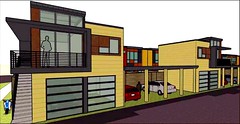 Kaufman notes on her blog that townhomes will have options for having carports, garages, or even garages with carriage house units on top (which can help bring in income if it is rented out, or can be perfect for an in-law suite, nanny suite, or a working studio), all of which will face rear alleys. There are also some live/work units and condos, as noted.
Kaufman notes on her blog that townhomes will have options for having carports, garages, or even garages with carriage house units on top (which can help bring in income if it is rented out, or can be perfect for an in-law suite, nanny suite, or a working studio), all of which will face rear alleys. There are also some live/work units and condos, as noted.
There is transit service along the adjoining, north-south Federal Boulevard, as well as along West 56th Avenue, running east-west two blocks to the north, and Regis Boulevard, running east-west two blocks to the south. There are enough pre-existing nearby shops, services and amenities to give the intersection of Federal and 52nd a pre-development Walk Score of 65; that will only improve when the commercial portion of Aria is in place. Regis University is to the site's immediate southwest.
Kaufman, who wrote a book on green modular construction, has guided Aria's green building features. They are explained in the project's information packet, and include use of renewable and recycled materials; waste savings from modular construction\; energy-efficient exterior and interior construction, appliances, lighting, and building systems; water-conserving fixtures and appliances; advanced stormwater management; measures to preserve indoor air quality and a healthy environment; and more. The site planning is designed to meet LEED-ND standards.
Aria appears to an extremely well-conceived project that could become a new model for modular smart, sustainable development. It will be fun to follow its progress. For more information, start with Michelle Kaufman's blog or the official Aria website.
